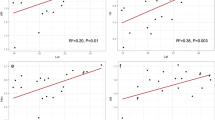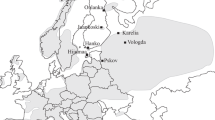Abstract
Fifteen populations of Abies nordmanniana, originating from all main parts of its distributional area in the Caucasian region, were genotyped for three chloroplast microsatellites as well as one mitochondrial marker. The chloroplast microsatellites were highly variable, resulting in a total of 111 haplotypes in 361 analysed individuals, while the mitochondrial marker showed no variation. Analysis of molecular variance attributed 2.1% of the variation in the microsatellites to be among populations, and no correlation between geographic distribution and genetic distances among populations could be observed. A simulation study was conducted to investigate to what extent the low genetic differentiation among populations could be a result of size homoplasy in the applied microsatellites. However, the simulations indicated that the low differentiation more likely is caused by high gene flow among populations.



Similar content being viewed by others
References
Arbez M (1967) Abies Nordmanniana Spach, Abies Bornmuelleriana Mattfeld. Ann Sci For 24:121–156
Arbez M (1969) Réparation, écologie et variabilité des sapins de Turquie du nord: Abies Nordmanniana Spach, Abies Bornmuelleriana Mattfeld, Abies equi-trojani Ascherson et Sintenis. Ann Sci For 26:257–284
Austerlitz F, Mariette S, Machon N, Gouyon PH, Godelle B (2000) Effects of colonization processes on genetic diversity: differences between annual plants and tree species. Genetics 154:1309–1321
Avise JC (2004) Molecular markers, natural history, and evolution, 2nd edn. Sinauer Associates, Inc., Sunderland, MA, USA (684 pages)
Bowcock AM, Ruiz Linares A, Tomfohrde J, Minch E, Kidd JR (1994) High resolution of human evolutionary trees with polymorphic microsatellites. Nature 368:455–457
Bucci G, Vendramin GG (2000) Delineation of genetic zones in the European Norway spruce natural range: preliminary evidence. Mol Ecol 9:923–934
Clark CM, Wentworth TR, O'Malley DM (2000) Genetic discontinuity revealed by chloroplast microsatellites in eastern North American Abies (Pinaceae). Am J Bot 87:774–782
Clegg MT, Gaut BS, Learn GH, Morton BR (1994) Rates and patterns of chloroplast DNA evolution. Proc Natl Acad Sci U S A 91:6795–6801
Cuenca A, Escalante AE, Piñero D (2003) Long-distance colonization, isolation by distance, and historical demography in a relictual Mexican pinyon pine (Pinus nelsonii Shaw) as revealed by paternally inherited genetic markers (cpSSRs) Mol Ecol 12:2087–2097
Digiovanni F, Kevan PG, Arnold J (1996) Lower planetary boundary layer profiles of atmospheric conifer pollen above a seed orchard in northern Ontario, Canada. For Ecol Manag 83:87–97
Di Rienzo A, Peterson AC, Garza JC, Valdes AM, Slatkin M, Freimer NB (1994) Mutational processes of simple-sequence repeat loci in human-populations. Proc Natl Acad Sci U S A 91:3166–3170
Echt CS, DeVerno LL, Anzidei M, Vendramin GG (1998) Chloroplast microsatellites reveal population genetic diversity in red pine, Pinus resinosa Ait. Mol Ecol 7:307–316
Estoup A, Tailliez C, Cornuet JM, Solignac M (1995) Size homoplasy and mutational processes of interrupted microsatellites in 2 bee species, Apis mellifera and Bombus terrestris (Apidae). Mol Biol Evol 12:1074–1084
Estoup A, Jarne P, Cornuet JM (2002) Homoplasy and mutation model at microsatellite loci and their consequences for population genetics analysis. Mol Ecol 11:1591–1604
Excoffier L, Smouse PE, Quattro JM (1992) Analysis of molecular variance inferred from metric distances among DNA haplotypes—application to human mitochondrial–DNA restriction data. Genetics 131:479–491
Farjon A, Rushforth KD (1989) A classification of Abies miller (Pinaceae). Notes R Bot Gard Edinb 46:59–79
Garza JC, Slatkin M, Freimer NB (1995) Microsatellite allele frequencies in humans and chimpanzees, with implications for constraints on allele size. Mol Biol Evol 12:594–603
Goldstein DB, Linares AR, Cavallisforza LL, Feldman MW (1995) An evaluation of genetic distances for use with microsatellite loci. Genetics 139:463–471
Gomez A, Gonzalez-Martinez SC, Collada C, Climent J, Gil L (2003) Complex population genetic structure in the endemic Canary Island pine revealed using chloroplast microsatellite markers. Theor Appl Genet 107:1123–1131
Hardy OJ, Vekemans X (2002) SPAGeDi: a versatile computer program to analyse spatial genetic structure at the individual or population levels. Mol Ecol Notes 2:618–620
Hardy OJ, Charbonnel N, Freville H, Heuertz M (2003) Microsatellite allele sizes: A simple test to assess their significance on genetic differentiation. Genetics 163:1467–1482
Jacobsen F (1988) Juletræer og Klippegrønt. In: Henriksen HA (ed) Skoven og dens dyrkning. Dansk Skovforening, Nyt Nordisk forlag Arnold Busck, Copenhagen, pp 607–636
Jarne P, Lagoda PJL (1996) Microsatellites, from molecules to populations and back. Trends Ecol Evol 11:424–429
Karhu A, Hurme P, Karjalainen M, Karvonen P, Karkkainen K, Neale D, Savolainen O (1996) Do molecular markers reflect patterns of differentiation in adaptive traits of conifers? Theor Appl Genet 93:215–221
Konnert M, Bergmann F (1995) The geographical distribution of genetic variation of silver fir (Abies alba, Pinaceae) in relation to its migration history. Plant Syst Evol 196(12):19–30
Larsen JB, Larsen BG, Kromann HK (1984) Abies nordmanniana provenienser til pyntegront og juletraeer (Provenances of Abies nordmanniana for greenery and Christmas tree production). Forstl Forsvaes Dan 39:363–382
Larsen JB (1997) Traearts og proveniensvalget i et baeredygtigt skovbrug (Tree species and provenance choice in sustainable forestry). Dan Skovbr Tidsskr 82:1–253
Latta RG, Linhart YB, Fleck D, Elliot M (1998) Direct and indirect estimates of seed versus pollen movement within a population of ponderosa pine. Evolution 52:61–67
Liepelt S, Kuhlenkamp V, Anzidei M, Vendramin GG, Ziegenhagen B (2001) Pitfalls in determining size homoplasy of microsatellite loci. Mol Ecol Notes 1:332–335
Liepelt S, Bialozyt R, Ziegenhagen B (2002) Wind-dispersed pollen mediates postglacial gene flow among refugia. Proc Natl Acad Sci U S A 99:14590–14594
Liu T-S (1971) A monograph of the genus Abies. Department of Forestry, National Taiwan University, Taipei, Taiwan, China
Løfting ECL (1961) Abies nordmanniana i Kaukasus. Dan Skovforen Tidsskr 46:426–455
Løfting ECL (1973) A survey of the present state of Abies nordmanniana in Denmark. Forstl Forsøgsvæs Dan 33:303–326
Madsen SF (1994) Provenance trial of Abies nordmanniana and Abies bornmuelleriana for Christmas tree production in North Sealand. For Landsc Res 1:143–166
Mills LS, Allendorf FW (1996) The one-migrant-per-generation rule in conservation and management. Conserv Biol 10:1509–1518
Nauta MJ, Weissing FJ (1996) Constraints on Allele size at microsatellite loci: implications for genetic differentiation. Genetics 143:1021–1032
Nei M (1987) Molecular evolutionary genetics. Columbia University Press, New York
Nielsen UB (1993) Breeding noble fir (Abies procera Rehder) and nordmann fir (Abies nordmanniana (Stev.) Spach) for Christmas trees and greenery in Denmark. Proceedings of the Nordic group for tree breeding, Forestry Commision, Edinburgh, Scotland, pp 118–127
Palme AE, Semerikov V, Lascoux M (2003) Absence of geographical structure of chloroplast DNA variation in sallow, Salix caprea L. Heredity 91:465–474
Parducci L, Szmidt AE, Madaghiele A, Anzidei M, Vendramin GG (2001) Genetic variation at chloroplast microsatellites (cpSSRs) in Abies nebrodensis (Lojac.) Mattei and three neighboring Abies species. Theor Appl Genet 102:733–740
Provan J, Powell W, Hollingsworth PM (2001) Chloroplast microsatellites: new tools for studies in plant ecology and evolution. Trends Ecol Evol 16:142–147
Ribeiro MM, Plomion C, Petit R, Vendramin GG, Szmidt AE (2001) Variation in chloroplast single-sequence repeats in Portuguese maritime pine (Pinus pinaster Ait.). Theor Appl Genet 102:97–103
Ribeiro MM, Mariette S, Vendramin GG, Szmidt AE, Plomion C, Kremer A (2002) Comparison of genetic diversity estimates within and among populations of maritime pine using chloroplast simple-sequence repeat and amplified fragment length polymorphism data. Mol Ecol 11:869–877
Robledo-Arnuncio JJ, Gil L (2005) Patterns of pollen dispersal in a small population of Pinus sylvestris L. revealed by total-exclusion paternity analysis. Heredity 94:13–22
Schneider S, Roessli D, Excoffier L (2000) Arlequin ver. 2.000: a software for population genetic data analysis. Genetics and Biometry Laboratory, University of Geneva, Switzerland
Semerikov VL, Lascoux M (2003) Nuclear and cytoplasmic variation within and between Eurasian Larix (Pinaceae) species. Am J Bot 90:1113–1123
Slatkin M (1995) A measure of population subdivision based on microsatellite allele frequencies. Genetics 139:457–462
Spitze K (1993) Population-structure in Daphnia obtusa—quantitative genetic and allozymic variation. Genetics 135:367–374
Vendramin GG, Lelli L, Rossi P, Morgante M (1996) A set of primers for the amplification of 20 chloroplast microsatellites in Pinaceae. Mol Ecol 5:595–598
Vendramin GG, Ziegenhagen B (1997) Characterisation and inheritance of polymorphic plastid microsatellites in Abies. Genome 40:857–864
Vendramin GG, Degen B, Petit RJ, Anzidei M, Madaghiele A, Ziegenhagen B (1999) High level of variation at Abies alba chloroplast microsatellite loci in Europe. Mol Ecol 8:1117–1126
Vendramin GG, Anzidei M, Madaghiele A, Sperisen C, Bucci G (2000) Chloroplast microsatellite analysis reveals the presence of population subdivision in Norway spruce (Picea abies K.). Genome 43:68–78
Viard F, El Kassaby YA, Ritland K (2001) Diversity and genetic structure in populations of Pseudotsuga menziesii (Pinaceae) at chloroplast microsatellite loci. Genome 44:336–344
Wakasugi T, Tsudzuki J, Ito S, Nakashima K, Tsudzuki T, Sugiura M (1994) Loss of all Ndh genes as determined by sequencing the entire chloroplast genome of the black pine Pinus thunbergii. Proc Natl Acad Sci U S A 91:9794–9798
Yang RC, Yeh FC, Yanchuk AD (1996) A comparison of isozyme and quantitative genetic variation in Pinus contorta ssp latifolia by F-ST. Genetics 142:1045–1052
Acknowledgements
The Danish Foundation “Foreningen Plan-Danmark” has supported O.K. Hansens' laboratory work and stay at Plant Genetics Institute, Florence, under the National Research Council, Italy. Thanks to Silvia Carnevale and Roberta Pastorelli for kind and patient help during the laboratory work.
Author information
Authors and Affiliations
Corresponding author
Rights and permissions
About this article
Cite this article
Hansen, O.K., Kjær, E.D. & Vendramin, G.G. Chloroplast microsatellite variation in Abies nordmanniana and simulation of causes for low differentiation among populations. Tree Genetics & Genomes 1, 116–123 (2005). https://doi.org/10.1007/s11295-005-0016-y
Received:
Revised:
Accepted:
Published:
Issue Date:
DOI: https://doi.org/10.1007/s11295-005-0016-y




